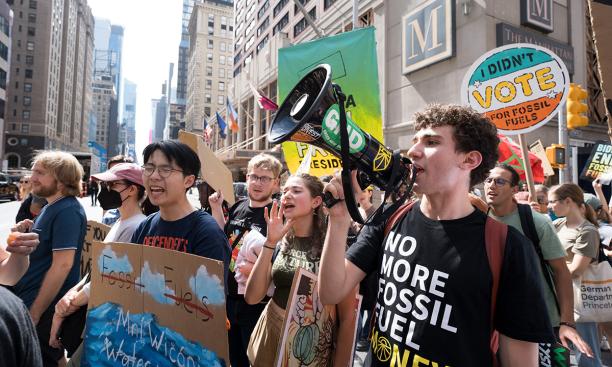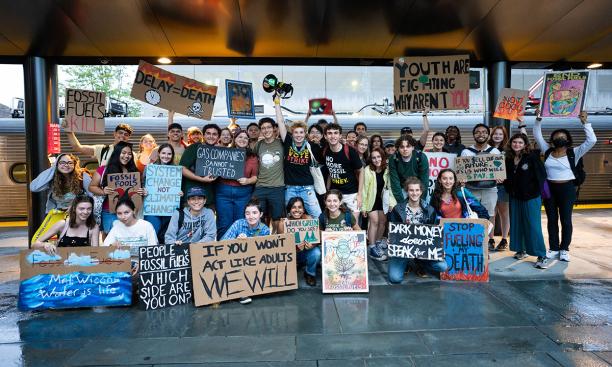
About 60 Princeton students joined an estimated 75,000 people during a climate march in New York City on Sept. 17. The March to End Fossil Fuels took place at the beginning of the U.N. General Assembly and had a heavy focus on President Joe Biden, demanding that his administration stop oil and gas projects and declare a climate emergency.
The effort to get Princeton students to the march was organized by two climate activist student groups on campus: Divest Princeton and Princeton Student Climate Initiative. The organizations also received funding from the University to pay for students’ train tickets to New York City.
The day started with a rally outside of the Wawa on campus, where students gathered to hear speeches and get pumped up before heading into the city. “It was kind of like a microcosm of what the protest was because it had that protest energy,” said Eleanor Clemans-Cope ’26, a co-coordinator of Divest Princeton, which has been advocating for the University to end fossil fuel-funded research on campus.
Once the students arrived in New York, they led chants on the subway, including: “When the climate is under attack, what do we do? Stand up, fight back!” They also gathered with other groups from New Jersey and sang a song before joining the march. The song, “Which Side Are You On?,” which was originally written in the 1930s during a conflict between miners and coal operators in Kentucky, had been rewritten to include new verses about fossil fuels and young people.
“Which side are you on? Are you on the side of fossil fuels or are you on the side of the youth? Because it is a choice, and Biden and the U.N. — everybody has to take a side,” Clemans-Cope said.

The focus on Biden’s administration was especially poignant given the United States’ exclusion from the Climate Ambition Summit, a special climate event during the General Assembly. The U.N.’s secretary general, António Guterres, only invited countries that have concrete and credible plans to address climate change, and he decided the U.S. does not fall in that category.
“If you’re following climate change science, we’re all very alarmed that the future for our children and grandchildren is looking very bleak,” said Lee Ketelsen ’77, who attended the march with her family, including her 4-year-old grandson, and a grassroots climate activist organization called Mothers Out Front.
“I’m glad that Princeton students and all students are getting active, because they will really be the leaders of the future,” Ketelsen said.
The Princeton students joined the youth contingent of the rally, leading chants through a megaphone and waving handmade signs they made the previous day. The march ended with speeches by Rep. Alexandria Ocasio-Cortez (D-N.Y.), UNICEF goodwill ambassador Vanessa Nakate, and several actors, including Susan Sarandon, Ethan Hawke, and Eve Ensler, who now goes by the name V.
“The march was really exciting, I was really happy to have gone there,” said Mauro Windholz, a fifth-year graduate student in the musicology department. “It took up an entire day and in grad school, especially in your fifth year, it’s hard to sacrifice an entire day in the middle of the semester for something like that, even on a Sunday. But I’m really glad that I made that sacrifice. I think it was worth it.”
Windholz added that he’s been concerned about climate issues for a long time and thinks it’s important for everyone to pay attention and organize around climate change, which he called a “pressing issue” that will impact everyone.
“We are damn mad about this, and we are very hopeful for what a green future, what a future with a just transition, can look like,” said Clemans-Cope, referring to a transition to a healthy and clean environment and economy that is as fair and inclusive as possible. “The atmosphere in the air was one of radical hope and righteous anger from the young people.”
